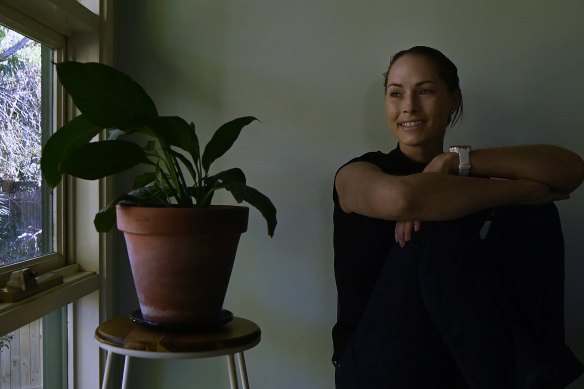By Laura Banks
Looking through the results of a DNA database, Amelia Lewis was confused to see a “self” or “twin” living in the United States. After contacting her genetic doppelganger, she was amazed to discover the woman who saved her life.
The serendipitous encounter with the woman who had anonymously donated the stem cells that helped Lewis beat cancer has inspired her and galvanised her efforts to encourage others to join the international donor registry.

Leukaemia survivor Amelia Lewis at home in Willoughby. Lewis received a stem cell transplant and now her DNA is a 100 per cent match with her donor.Credit: Kate Geraghty
Lewis was 20 and studying an arts degree at the University of Sydney in 2021 when she was diagnosed with acute myeloid leukaemia. After several rounds of chemotherapy, she began the search for a stem cell donor, with hope a transplant would help her body to “reboot”.
After high-dose chemotherapy or radiotherapy, a patient’s stem cells will often be diminished. A transfer from a donor enables the recipient’s body to create new blood cells with stem cells taken from the blood or bone marrow of a matched donor.
“My doctors searched an international donor registry to try to find a matching donor,” Lewis said.
“I was originally matched to a donor in the UK, but they were unable to follow through. Soon after, I matched with someone in the United States. All I was told is that the donor was a young American woman and that the process is required to remain anonymous.”
The transplant was successful and Lewis, originally from the Hunter Valley, returned to her studies.
At the beginning of this year, Lewis and her sister, Elizabeth, signed up to do a DNA test to trace their ancestry.
“I opened the app and first saw the DNA map, which was still primarily European, a little like my sister’s, but with distinct differences, such as no Italian heritage to be found,” Lewis said. “But instead there was 1 per cent Senegal and a map highlighting that people with my DNA were likely to have been American Upper Midwest, West Virginia, Kentucky and Tennessee settlers.”
Along with her results, the website flagged a “self/twin” match and indicated that Lewis shared DNA with a woman called Nicole. The two connected and discovered that Nicole was Lewis’ donor.
“It was an incredible moment being able to finally find the person who saved my life and being given the opportunity to personally thank her,” Lewis said.
How stem cell donation works
There are two ways to donate stem cells.
- Stem cells can be collected from bone marrow through a needle inserted into the back of the pelvic bone. This procedure is done under anesthetic and the donor can usually go home the same day.
- Peripheral stem cell donation requires the donor to receive injections that increase the number of stem cells in their bloodstream. Blood is then taken from the donor as it would be for a blood donation. A machine then separates the stem cells ready for transfer. It usually takes four to six hours.
- Anyone aged 18 to 35 who is in good health is eligible to donate. Source: Australian Red Cross Lifeblood
Websites that offer ancestry DNA testing advise people who have undergone bone marrow or stem cell transplants not to undertake the test as such treatment can affect the results.
Dr Jenny Wang, head of cancer and stem cell research at The University of Sydney, said the transfer of some DNA was expected during the stem cell donation procedure but that the patient retained their own DNA as well. She said finding a donor match could be difficult.
“Not every patient can do a stem cell transfer, it’s hard to find a match for stem cells and even family it’s hard to find a match, finding a donor is really the hardest part of the transplantation,” she said. “If it is not a good match, the immune system is not going to accept the transplant, and it is going to attack the transplant and make the patient very sick. That’s why we have the international register.”
Now 23, Lewis said she was “incredibly grateful” for Nicole’s “selflessness and generosity” and hoped that others might be inspired by their story.
“I’ve since learnt that Nicole originally donated because her sister was diagnosed with leukaemia in 2012,” she said.
“Her sister survived and thrived with other life-saving experimental drugs, and Nicole remained on the stem cell donor registry for seven years before receiving the call to donate her stem cells to a patient across the world.”
The Morning Edition newsletter is our guide to the day’s most important and interesting stories, analysis and insights. Sign up here.